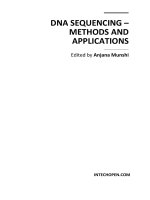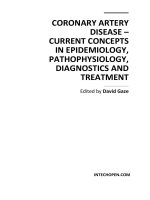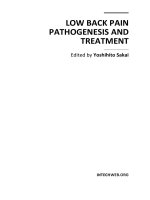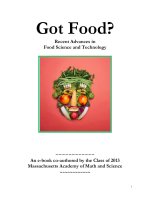RECENT ADVANCES IN DOCUMENT RECOGNITION AND UNDERSTANDING Edited by Minoru Mori pptx
Bạn đang xem bản rút gọn của tài liệu. Xem và tải ngay bản đầy đủ của tài liệu tại đây (4.07 MB, 102 trang )
RECENT ADVANCES IN
DOCUMENT RECOGNITION
AND UNDERSTANDING
Edited by Minoru Mori
Recent Advances in Document Recognition and Understanding
Edited by Minoru Mori
Published by InTech
Janeza Trdine 9, 51000 Rijeka, Croatia
Copyright © 2011 InTech
All chapters are Open Access distributed under the Creative Commons Attribution 3.0
license, which permits to copy, distribute, transmit, and adapt the work in any medium,
so long as the original work is properly cited. After this work has been published by
InTech, authors have the right to republish it, in whole or part, in any publication of
which they are the author, and to make other personal use of the work. Any republication,
referencing or personal use of the work must explicitly identify the original source.
As for readers, this license allows users to download, copy and build upon published
chapters even for commercial purposes, as long as the author and publisher are properly
credited, which ensures maximum dissemination and a wider impact of our publications.
Notice
Statements and opinions expressed in the chapters are these of the individual contributors
and not necessarily those of the editors or publisher. No responsibility is accepted for the
accuracy of information contained in the published chapters. The publisher assumes no
responsibility for any damage or injury to persons or property arising out of the use of any
materials, instructions, methods or ideas contained in the book.
Publishing Process Manager Niksa Mandic
Technical Editor Teodora Smiljanic
Cover Designer Jan Hyrat
Image Copyright Olaru Radian-Alexandru, 2010. Used under license from
Shutterstock.com
First published October, 2011
Printed in Croatia
A free online edition of this book is available at www.intechopen.com
Additional hard copies can be obtained from
Recent Advances in Document Recognition and Understanding, Edited by Minoru Mori
p. cm.
ISBN 978-953-307-320-0
free online editions of InTech
Books and Journals can be found at
www.intechopen.com
Contents
Preface VII
Chapter 1 Statistical Deformation Model
for Handwritten Character Recognition 1
Seiichi Uchida
Chapter 2 Character Recognition with Metasets 15
Bartłomiej Starosta
Chapter 3 Recognition of Tifinaghe Characters Using
Dynamic Programming & Neural Network 35
Rachid El Ayachi, Mohamed Fakir and Belaid Bouikhalene
Chapter 4 Character Degradation Model and HMM Word
Recognition System for Text Extracted from Maps 53
Aria Pezeshk and Richard L. Tutwiler
Chapter 5 Grid’5000 Based Large Scale OCR Using the DTW Algorithm:
Case of the Arabic Cursive Writing 73
Mohamed Labidi, Maher Khemakhem and Mohamed Jemni
Chapter 6 Application of Gaussian-Hermite
Moments in License 85
Lin Wang, Xinggu Pan, ZiZhong Niu and Xiaojuan Ma
Preface
In the field of document recognition and understanding, whereas scanned paper
documents were previously the only recognition target, various new media such as
camera-captured documents, videos, and natural scene images have recently started to
attract attention because of the growth of the Internet/WWW and the rapid adoption
of low-priced digital cameras/videos. The keys to the breakthrough include character
detection from complex backgrounds, discrimination of characters from non-
characters, modern or ancient unique font recognition, fast retrieval technique from
large-scaled scanned documents, multi-lingual OCR, and unconstrained handwriting
recognition. This book aims to present recent advances, applications, and new ideas
that are relevant to document recognition and understanding, from technical topics
such as image processing, feature extraction or classification, to new applications like
camera-based recognition or character-based natural scene analysis. The goal of this
book is to provide a new trend and a reference source for academic research and for
professionals working in the document recognition and understanding field.
Minoru Mori
NTT Communication Science Laboratories, NTT Corp.,
Japan
0
Statistical Deformation Model for Handwritten
Character Recognition
Seiichi Uchida
Kyushu University
Japan
1. Introduction
One of the main problems of offline and online handwritten character recognition is how
to deal with the deformations in characters. A promising strategy to this problem is
the incorporation of a deformation model. If recognition can be done with a reasonable
deformation model, it may become tolerant to deformations within each character category.
There have been proposed many deformation models and some of them were designed
in an empirical manner. Recognition methods based on elastic matching have often
relied on a continuous and monotonic deformation model (Bahlmann & Burkhardt, 2004;
Burr, 1983; Connell & Jain, 2001; Fujimoto et al., 1976; Yoshida & Sakoe, 1982). This is a
typical empirical model and has been developed according to the observation that character
patterns often preserve their topologies. Affine deformation models (Wakahara, 1994;
Wakahara & Odaka, 1997; Wakahara et al., 2001) and local perturbation models (or image
distortion models (Keysers et al., 2004)) are also popular empirical deformation models.
While the empirical models generally work well in handwritten character recognition tasks,
they are not well-grounded by actual deformations of handwritten characters. In addition, the
empirical models are just approximations of actual deformations and they cannot incorporate
category-dependent deformation characteristics. In fact, the category-dependent deformation
characteristics exist. For example, in category “M”, two parallel vertical strokes are often
slanted to be closer. In contrast, in category “H”, however, the same deformation is rarely
observed.
Statistical models are better alternatives to the empirical models. The statistical models
learn deformation characteristics from actual character patterns. Thus, if a model learns
the deformations of a certain category, it can represent the category-dependent deformation
characteristics.
Hidden Markov model (HMM) is a popular statistical model for handwritten characters
(e.g., (Cho et al., 1995; Hu et al., 1996; Kuo & Agazzi, 1994; Nag et al., 1986; Nakai et al.,
2001; Park & Lee, 1998)). HMM has not only a solid stochastic background and but also
a well-established learning scheme. HMM, however, has a limitation on regulating global
deformation characteristics; that is, HMM can regulate local deformations of neighboring
regions due to its Markovian property.
This chapter is concerned with another statistical deformation model of offline and online
handwritten characters. This deformation model is based on a combination of elastic matching
and principal component analysis (PCA) and also capable of learning actual deformations of
1
2 Will-be-set-by-IN-TECH
x
y
i
j
R ={ r
i,j
} E ={ e
x,y
}
2D-2D mapping
F
(2D warping)
(x, y)
(i, j)
Fig. 1. Elastic matching between two character images.
handwritten characters. Different from HMM, this deformation model can regulate not only
local deformations but also global deformations. In the following, the contributions of this
chapter are summarized.
1.1 Contributions of t his chapter
The first contribution of this chapter is to introduce a statistical deformation model for offline
handwritten character recognition. The model is realized by two steps. The first step is the
automatic extraction of the deformations of character images by elastic matching. Elastic
matching is formulated as an optimization problem of the pixel-to-pixel correspondence
between two image patterns. Since the resulting pixel-to-pixel correspondence represents
the displacement of individual pixels, i.e., the deformation of one character image from
another. The second step is statistical analysis of the extracted deformations by PCA. The
resulting principal components, called eigen-deformations, represent intrinsic deformations of
handwritten characters.
The second contribution is to introduce a statistical deformation model for online handwritten
character recognition. While the discussion is similar to the above offline case, it is different
in several points. For example, deformations often appear as the difference in pattern
length. Consequently, online handwritten character patterns have rarely been handled in
a PCA-based statistical analysis framework, which assumes the same dimensionality of
subjected patterns. In addition, online handwritten character patterns often undergo heavy
nonlinear temporal/spatial fluctuation. Elastic matching to extract the relative deformation
between two patterns solves these problems and helps to establish a statistical deformation
model.
2. Statistical deformation model of offline handwritten character recognition
2.1 Extraction of deformations by el astic matc hing
The first step for statistical deformation analysis of handwritten character images is the
extraction of deformations of actual handwritten character images and it can be done
automatically by elastic matching. Elastic matching is formulated as the following
optimization problem. Consider an I
× I reference character image R = {r
i,j
} and an
I
× I input character image E = {e
x,y
},wherer
i,j
and e
x,y
are d-dimensional pixel feature
vectors at pixel
(i, j) on R and (x, y) on E, respectively. Let F denote a 2D-2D mapping
from R to E, i.e., F :
(i, j) → (x, y). As shown in Figure 1, the mapping F determines the
2
Recent Advances in Document Recognition and Understanding
Statistical Deformation Model for Handwritten Character Recognition 3
x
y
Fig. 2. Eigen-deformations of handwritten characters.
pixel-to-pixel correspondence from R to E. Elastic matching between R and E is formulated
as the minimization problem of the following objective function with respect to F :
J
R,E
(F )=R −E
F
,(1)
where E
F
is the character image obtained by fitting E to R, i.e., E
F
= {e
x
i,j
,y
i,j
},and
(x
i,j
, y
i,j
) denotes the pixel of E corresponding to the (i, j)th pixel of R under F .Onthe
minimization, several constraints (such as a smoothness constraint and boundary constraints)
are often assumed to regularize F .
Let
˜
F denote the mapping F which minimizes J
R,E
(F ) of (1). This mapping
˜
F represents
the relative deformation of the input image E from the reference image R. Specifically,
the deformation of E is extracted as the following 2I
2
-dimensional vector, called deformation
vector,
v
=((1 −x
1,1
,1− y
1,1
), ,(i − x
i,j
, j −y
i,j
), ,(I − x
I,I
, I −y
I,I
))
T
.(2)
Note that v is a discrete representation of
˜
F .
The constrained minimization of (1) with respect to F (i.e., the extraction of v)isdoneby
various optimization strategies. If the mapping F is defined as a parametric function, iterative
strategies and exhaustive strategies are often employed for optimizing the parameters of
F . In contrast, if the mapping F is a non-parametric function, combinatorial optimization
strategies, such as dynamic programming, local perturbation, and deterministic relaxation,
are employed. Various formulations and optimization strategies of the elastic matching
problem are summarized in Uchida & Sakoe (2005).
2.2 Estimations of eigen-deformations
Eigen-deformations of a category are intrinsic deformations of the category and defined
as M principal axes
{u
1
, ,u
m
, ,u
M
} which span an M-dimensional subspace in the
2I
2
-dimensional deformation space. The eigen-deformations can be estimated by applying
3
Statistical Deformation Model for Handwritten Character Recognition
4 Will-be-set-by-IN-TECH
u
1
0-2 +2
diff
0-2 +2
0-2 +2
u
2
u
3
Fig. 3. Reference pattern R deformed by top three eigen-deformations, u
1
, u
2
,andu
3
.
cumulative proportion (%)
0
20
40
60
80
100
top 10
top 20
top 30
ABCDE FGHI JKLMNOPQRS TUVWXY Z
top 1
top 3
top 5
Fig. 4. Category-wise cumulative proportion ρ(M) of eigen-deformations at
M
= 1, 3, 5, 10, 20, and 30. Note that ρ(M)=100% at M = 74.
PCA to
{v
n
|n = 1, ,N},wherev
n
is the extracted deformation between R and E
n
.
Specifically, the eigen-deformations are obtained as the eigen-vectors of the covariance matrix
Σ
=
∑
n
(v
n
−v)(v
n
−v)
T
/N,wherev is the mean vector of {v
n
}.
Figure 2 shows the first three eigen-deformations estimated from 500 handwritten characters
of the category “A”. The first eigen-deformation u
1
, that is, the most frequent deformation of
“A”, was the global slant transformation. The second was the vertical shift of the horizontal
4
Recent Advances in Document Recognition and Understanding
Statistical Deformation Model for Handwritten Character Recognition 5
stroke and the third was the width variation of the upper part. Consequently, this figure
confirms that frequent deformations of “A” were extracted successfully.
Note that in this experiment, the dimensionality of the deformation vector v was 74 though
the size of the character image pattern was 20
× 20 (i.e., I = 20 and 2I
2
= 800). This is
because a “sparse” EM was used where the displacements of 3 pixels (leftmost, middle, and
rightmost) were optimized at every row. The displacements of the other pixels were given by
linear interpolation.
Figure 3 shows the patterns R deformed by the first three eigen-deformations u
1
, u
2
,and
u
3
with the amplification with k
√
λ
m
(k = −2, −1, 0, 1, 2),whereλ
m
is the eigenvalue of
the mth eigenvector. This figure also show that frequent deformations were extracted as the
eigen-deformation at each category.
Figure 4 shows the cumulative proportion of each category. The cumulative proportion by
the top M eigen-deformations is defined as ρ
(M)=
∑
M
m
=1
λ
m
/
∑
74
m
=1
λ
m
. In all categories, the
cumulative proportion exceeded 50% with the top 3
∼ 5 eigen-deformations and 80% with
the top 10
∼ 20 eigen-deformations. Thus, the distribution of deformation vectors was not
isotropic and can be approximated by a small number of eigen-deformations. In other words,
there existed a low-dimensional and efficient subspace of deformations.
2.3 Recognition with eigen-deformations (1)
The eigen-deformations can be utilized for recognizing handwritten character images. A
direct use of the eigen-deformations for evaluating a distance between two characters R and
E is as follows:
D
disp
(R, E )=(v −v)
T
Σ
−1
(v −v)=
2I
2
∑
m=1
1
λ
m
v −v, u
m
2
,(3)
where E is an unknown input image and v is the deformation extracted by the elastic
matching between R and E. This is the well-known Mahalanobis distance and evaluates
the statistical divergence of the estimated deformation on E from the deformations which
usually appear in the category of R. If the estimated deformation v gives a large distance
value, the result of elastic matching between E and R is somewhat abnormal and therefore
the category of R will not become a candidate of the correct category of E.
The recognition performance by D
disp
(R, E) alone, however, is not satisfactory. This is
because the distance D
disp
(R, E ) completely neglects the distance of pixel features. This fact
will be certified through an experimental result in 2.5.
An alternative and reasonable choice is the linear combination of the distance in the pixel
feature space and the distance in the deformation space (Uchida & Sakoe, 2003b), that is,
D
hybrid
(R, E )=(1 −w)D
feat
(R, E )+wD
disp
(R, E ),(4)
where D
feat
(R, E) is the elastic matching distance in the pixel feature space, i.e.,
D
feat
(R, E )=J
R,E
(
˜
F
),(5)
and w is a constant (0
≤ w ≤ 1) to ballance two distances.
In practice, the modified Mahalanobis distance (Kimura et al., 1987) is employed instead of
(3). Specifically, the higher-order eigenvalues λ
m
(m = M + 2, ,2I
2
) are replaced by
5
Statistical Deformation Model for Handwritten Character Recognition
6 Will-be-set-by-IN-TECH
+α
−α
manifold {R
F(α)
}
R
E
tangent plane
T
α
tangent
distance
D
TD
(R, E )
−α
+α
Fig. 5. Manifold R
α
, its tangent plane T
α
, and tangent distance D
TD
(R, E ).
Fig. 6. Tangent vectors of the category “A”, derived from R and eigen-deformations u
1
, u
2
,
and u
3
.
λ
M +1
, to suppress the estimation errors of higher-order eigenvalues in (3). According to this
replacement, (3) is reduced to
D
disp
(R, E ) ∼
1
λ
M +1
v − v +
M
∑
m=1
1
λ
m
−
1
λ
M +1
v −v, u
m
2
.(6)
The parameter M is to be determined experimentally, for example, considering the cumulative
proportion ρ
(M).
2.4 Recognition with eigen-deformations (2)
The above recognition method has a weak-point that two heterogeneous distances D
feat
and
D
disp
are added naively to create the single distance D
hybrid
. In contrast, the following method
(Uchida & Sakoe, 2003a) can avoid this weak-point by embedding the eigen-deformations into
an elastic matching procedure.
Consider that the mapping F is defined as a linear combination of eigen-deformations, i.e.,
F
(α)=
M
∑
m=1
α
m
u
m
,(7)
where α
=(α
1
, ,α
m
, ,α
M
)
T
. Then an elastic matching problem with F (α) can be
formulated as the minimization problem of the following objective function:
J
R,E
(α)=
R
F (α)
−E
,(8)
where R
F (α)
is the reference pattern deformed by the mapping F (α).
The set of deformed reference patterns,
{R
F (α)
|∀α}, will form an M-dimensional manifold in
an
(I
2
·d)-dimensional pixel feature space. Thus the minimum value of J
R,E
(α) is equivalent
to the shortest distance between the M-dimensional manifold and E.
6
Recent Advances in Document Recognition and Understanding
Statistical Deformation Model for Handwritten Character Recognition 7
averaged computation time (ms)
98.0
98.2
98.4
98.6
98.8
99.0
99.2
99.4
0.01 0.1 1 10 100 1000
recognition rate (%)
D
feat
M=1
50
99.6
rigid
matching
D
hybrid
D
TD
D
disp
(93.6%)
2
3
6
10
20
5
Fig. 7. Relation between computation time (ms) and recognition rate (%).
The minimization problem (8) with respect to α is hard to solve directly. This is because the
M-dimensional parameter vector α to be optimized is involved in the nonlinear function R.
Thus, some approximation is required to solve the optimization problem.
In Uchida & Sakoe (2003a), the approximation scheme used in the tangent distance method
(Simard et al., 1992) has been employed for the above minimization problem. As shown in
Fig. 5, the minimum distance min
α
J
R,E
(α) can be approximated by the following tangent
distance,
D
TD
(R, E )=min
α
T
α
−E
,(9)
where T
α
is the tangent plane of the manifold at α = 0. The tangent plane is an M-dimensional
hyperplane in the feature space and linear with respect to α. Thus the minimization problem of
(9) has a closed-form solution. Intuitively speaking, the distance D
TD
(R, E ) is the Euclidean
distance between the input E and its closest point on the tangent plane. Figure 6 shows three
tangent vectors which span the tangent plane of the category “A”.
2.5 Recognition result
Figure 7 shows results of a handwritten character recognition experiment using 26 (categories)
×1,100 (samples) isolated handwritten English uppercase character images from the standard
character image database ETL6. The first 100 samples of each category were simply averaged
to create one reference pattern R and the next 500 samples were used as training samples E
n
to estimate the eigen-deformations. The remaining 500 samples (13, 000 = 26 ×500 samples
in total) were used as test samples E.
The highest recognition rate (99.47%) was attained by D
hybrid
with its best weight w.The
recognition rate by D
disp
, i.e., the recognition rate by evaluating only the deformation v,was
not sufficient. Thus, the pixel features (i.e., appearance features) should not be neglected for
evaluating the distance of two character images. The recognition rates by D
TD
were saturated
around M
= 3. This result is supported by the fast saturation of the cumulative proportion of
Fig. 4.
7
Statistical Deformation Model for Handwritten Character Recognition
8 Will-be-set-by-IN-TECH
2.6 Related work
The original idea of the eigen-deformations, i.e., principal components of deformations, can
be found in the point distribution models (PDM), which has been proposed by Cootes et al.
(1995) and applied to various patterns. Shen & Davatzikos (2000) have introduced an
automatic deformation collection scheme into the PDM. PDM for curvilinear patterns has
been applied to face recognition (Lanitis et al., 1997), Chinese character recognition (Shi et al.,
2003), and hand posture recognition (Ahmed et al., 1997). Uchida & Sakoe (2003b) have
extended the PDM to deal with fully 2D deformations and have applied to an elastic
matching-based handwritten character recognition system.
Iwai et al. (1997) have applied PCA to interframe motion vector fields obtained by block
matching, which can be considered as the simplest elastic matching. Bing et al (2002) have
proposed a face expression recognition method based on a subspace of face deformations.
Naster et al. (1997) have analyzed a deformation vector extended to deal with the variation of
the pixel feature value. Those ideas will be promising for recognizing handwritten character
images.
The eigen-deformations are the principal axes spanning a subspace of the 2I
2
-dimensional
deformation space. Any point on the subspace represents a deformation F . On the other
hands, we can consider a subspace on the
(I
2
· d)-dimensional pixel feature space. Any
point on the subspace represents an I
× I × d image pattern. The axes spanning this
subspace are derived as dominant eigen-vectors of the covariance matrix Σ
=
∑
n
(E
n
−
E)(E
n
− E )
T
/N,whereE is the mean vector of {E
n
}. There are huge research
attempts about the subspace (Oja, 1983). Eigenface (Turk & Pentland, 1991) and parametric
eigenspace (Hase et al., 2003; Murase & Nayar, 1994) are famous examples of those attempts.
While the subspace derived in the above manner can represent a set of deformed character
patterns, the subspace spanned by the eigen-deformations will represent the same set in a
more compact manner. Consider a character image R and a set of character images created
by translating R. The number of the eigen-deformations estimated from the set is two; one
will represent horizontal shift and the other vertical shift. In contrast, the number of the
principal eigen-vectors in the pixel feature space will be far larger than two. This superiority
will hold for other geometric deformations and thus the subspace of deformations can be a
more efficient representation than the subspace of the pixel features.
3. Statistical deformation model of online handwritten character recognition
3.1 Extraction of deformations by elastic matching
Consider two online handwritten character patterns, R = r
1
, r
2
, ,r
i
, ,r
I
and E = e
1
, e
2
,
,e
x
, ,e
I
. The former is a reference character pattern and the latter is an input character
pattern. Their elements r
i
and e
x
are d-dimensional feature vectors representing the features
at i and x; they are often 3-dimensional vectors comprised of x-coordinate, y-coordinate, and
local direction.
Let F denote a 1D-1D mapping from R to E, i.e., F : i
→ x.Figure8depictsF . Elastic
matching between R and E is formulated as the minimization of the following objective
function with respect to F ,
J
R,E
(F )=
R −E
F
, (10)
where E
F
is the character pattern obtained by fitting E to R, i.e., E
F
= e
x
1
, ,e
x
i
, ,e
x
I
,
where x
i
represents the i − x correspondence under F . On the minimization, several
8
Recent Advances in Document Recognition and Understanding
Statistical Deformation Model for Handwritten Character Recognition 9
time
i
x
r
i
e
x
mapping
F
time
I
I‘
Fig. 8. Elastic matching between two online handwritten character patterns.
constraints (such as the monotonicity and continuity constraint defined as x
i
− x
i−1
∈
{
0, 1, 2} and boundary constraints x
1
= 1andx
I
= I
) are often assumed to regularize F .
This constrained minimization problem can be solved effectively by a DP algorithm, called
dynamic time warping or DP matching, and its detail are omitted here.
The deformation of E from R is represented by the following
(I ·d)-dimensional deformation
vector,
v
=
(
e
x
1
−r
1
, ,e
x
i
−r
i
, ,e
x
I
−r
I
)
T
. (11)
It should be noted that the dimension of the above deformation vector v is fixed at
(I · d)
and independent of the length of E, i.e., I
. This property is very important to apply various
statistical methods, such as PCA, to sequential patterns.
Also note that it is possible to define v as
v
=
(
1 − x
1
, ,i − x
i
, ,I −x
I
)
T
.
Although this definition is a straightforward modification of the deformation vector of (2), we
will use v of (11) as a deformation vector here. This is because in online character recognition,
r
i
and e
x
are often spatial features and thus their difference represents a deformation.
3.2 Estimation of eigen-deformations
Eigen-deformations of online handwritten character patterns are also estimated by the
procedure of 2.2; that is, they can be estimated as dominant eigen-vectors of the covariance
matrix of v.
Eigen-deformations of online handwritten digits were estimated by using about 1,000 samples
from UNIPEN Train-R01/V07 database (1a) (Guyon et al., 1994). Figure 9 shows character
patterns generated by R
+ v ± 2
√
λ
m
u
m
(m = 1, 2) (Mitoma et al., 2005). That is, those
patterns are reference patterns deformed by their mean deformation vector
v and the first
two eigen-deformations u
m
. Note that the effect of v was not significant because R was set
around the center of the set of the training samples by a clustering technique and thus the
norm of
v was small.
Figure 9 shows that deformations frequently observed in actual characters were estimated as
eigen-deformations. For example, the first eigen-deformation of “6” represents the vertical
variation of its loop part, and the second one represents the horizontal variation of the loop
part.
9
Statistical Deformation Model for Handwritten Character Recognition
10 Will-be-set-by-IN-TECH
1st eigen-deformation 2nd eigen-deformation
reference
reference +
eigen-def.
reference -
eigen-def.
Fig. 9. Reference character pattern deformed by the first two eigen-deformations of “2” and
“6”.
88
90
92
94
96
98
50 100 150 200
recognition rate (%)
#reference patterns
D
MQDF
D
DP
Fig. 10. Accuracy of online character recognition based on eigen-deformations.
3.3 Recognition with eigen-deformations
For online handwritten character recognition based on the eigen-deformations, the following
quadratic discrimination function (QDF) is a possible choice (Mitoma et al., 2005). The QDF
is the Bayes discrimination function under the assumption that the deformation vectors have
a Gaussian distribution and defined as
D
QDF
(R, E )=(v − v)
T
Σ
−1
(v −v)+log |Σ| +(I · d) log 2π
=
I·d
∑
m=1
1
λ
m
v −v, u
m
2
+ log
I·d
∏
m=1
λ
m
+(I ·d) log 2π. (12)
The last term,
(I · d) log 2π, cannot be omitted here because each category has a different
dimension of v (i.e., I
·d).
10
Recent Advances in Document Recognition and Understanding
Statistical Deformation Model for Handwritten Character Recognition 11
As noted 2.3, the estimation errors of higher-order eigenvalues are amplified in (12). Thus, the
modified quadratic discriminant function (MQDF) (Kimura et al., 1987) was employed, where
the higher-order eigenvalues λ
m
(m = M + 1, ,I ·d) are replaced by λ
M +1
, i.e.,
D
MQDF
(R
c
, E) ∼
1
λ
M +1
v −v
2
+
M
∑
m=1
1
λ
m
−
1
λ
M +1
v −v, u
m
2
+ log
(λ
M +1
)
I·d−M
M
∏
m=1
λ
m
+(I ·d) log 2π. (13)
The parameter M is to be determined experimentally.
3.4 Recognition results
Figure 10 shows the results of an online character recognition experiment using digit samples
from the UNIPEN database. Recognition rates attained by D
MQDF
are plotted as a function
of the total number of reference patterns, which are created by a clustering technique. The
recognition rates attained by the conventional DP-matching distance (D
DP
), which equals to
the minimum value of (10), are also plotted.
As shown in Fig. 10, MQDF with the eigen-deformations outperformed the DP-matching
distance. This will be because elastic matching results F which were deviated from the
distribution of the deformations of the category were penalized by the eigen-deformations
in MQDF. Thus, the above recognition method can avoid misrecognitions due to overfitting,
which is the phenomenon that the distance between E and R of a wrong category is
underestimated by unnatural mapping F .
This result also proves that D
MQDF
outperforms that statistical dynamic time warping
(SDTW) (Bahlmann & Burkhardt, 2004), which is a recent and sophisticated online character
recognition technique. In fact, it has been reported in Bahlmann & Burkhardt (2004) that
SDTW attained 97.10% on the same UNIPEN data set by 150 reference patterns.
3.5 Related work
Sequential patterns, such as online handwritten character patterns, are often re-sampled to
have the same dimension in advance to applying PCA or other statistical analysis techniques.
For example, Deepu et al. (2004) have proposed an online character recognition technique
based on a subspace method where all online character patterns are re-sampled to have a
constant number of data points. The online character recognition technique by Zheng et al.
(1999) is more radical because they used only two points (i.e., the start point and the end point)
for each character stroke segment. In the handwriting synthesis technique by Wang et al.
(2005), online cursive handwritings are firstly aligned to be the same dimension and then PCA
is applied to them. PCA-based gesture/motion analysis techniques (Fod et al., 2002; Sanger,
1995; Yacoob & Black, 1999) also re-sampled gesture patterns to have the same dimension.
An exception is Martens & Claesen (1996), which employed elastic matching to extract a
fixed-dimensional deformation vector from online signatures.
4. Conclusion
Statistical deformation models of handwritten character images and online handwritten
character patterns have been introduced. The body of those models are eigen-deformations,
11
Statistical Deformation Model for Handwritten Character Recognition
12 Will-be-set-by-IN-TECH
which are deformations frequently observed in a certain category and span a subspace in a
deformation space of the category. For estimating the eigen-deformations, elastic matching
and principal component analysis (PCA) were employed. The former was utilized to extract
deformations of target patterns automatically. For the online patterns, elastic matching
was also utilized to adjust difference in their lengths. The latter was utilized to derive the
eigen-deformations as the principal components of the extracted deformations.
The usefulness of the statistical deformation models with eigen-deformations has been
confirmed experimentally. The estimated eigen-deformations could represent frequently
observed deformations in each character category. In addition, the eigen-deformations were
useful for improving accuracy in both of offline and online character recognition tasks.
5. References
Ahmad, T.; Taylor, C. J.; Lanitis, A. & Cootes, T. F. (1997). Tracking and recognising hand
gestures, using statistical shape models Image Vis. Computing, Vol. 15, pp. 345–352.
Bahlmann, C. & Burkhardt, H (2004). The writer independent online handwriting recognition
system flog on hand and cluster generative statistical dynamic time warping, IEEE
Trans. PAMI, Vol. 26, No. 3, pp. 299–310.
Bing, Y.; Ping, C. & Lianfu, J. (2002). Recognizing faces with expressions: within-class space
and between-class space, In: Proc. ICPR, Vol. 1 of 4, pp. 139–142.
Burr, D. J. (1983). Designing a handwriting reader, IEEE Trans. PAMI,Vol.PAMI-5,No.5,
pp. 554–559.
Cho, W.; Lee, S. -W. & Kim, J. H. (1995). Modeling and recognition of cursive words with
hidden Markov models, Pattern Recognit., Vol. 28, No. 12, pp. 1941–1953.
Connell, S. D. & Jain,A. K. (2001). Template-based online character recognition, Pattern
Recognit., Vol. 34, No. 1, pp. 1–14.
Cootes, T. F.; Taylor, C. J.; Cooper, D. H. & Graham, J. (1995). Active shape models - their
training and application, Comput. Vis. Image Und., Vol. 61, No. 1, pp. 38–59.
Deepu, V.; Madhvanath, S. & Ramakrishnan, A. G. (2004). Principal component analysis for
online handwritten character recognition, In: Proc. ICPR, Vol. 2 of 4 , pp. 327–330.
Fod, A.; Mataric, M. & Jenkins, O. C. (2002). Automated derivation of primitives for movement
classification, Autonomous Robots, Vol. 12, No. 1, pp. 39–54.
Fujimoto, Y.; Kadota, S.; Hayashi, S.; Yamamoto, M.; Yajima, S. & Yasuda, M. (1976).
Recognition of handprinted characters by nonlinear elastic matching, In: Proc. ICPR,
pp. 113–118.
Guyon, I.; Schomaker, L.; Plamondon, R.; Liberman, M. & Janet, S. (1994). UNIPEN project of
on-line data exchange and recognizer benchmarks, In: Proc. ICPR, pp. 29–33.
Hase, H.; Shinokawa, T.; Yoneda, M. & Suen, C. Y. (2003). Recognition of rotated characters by
eigen-space, In: Proc. ICDAR, Vol. 2, pp. 731–735.
Hu, J.; Brown, M. K. & Turin, W. (1996). HMM based on-line handwriting recognition, IEEE
Trans. PAMI, Vol. 18, No. 10, pp. 1039–1045.
Iwai, Y.; Hata, T. & Yachida, M. (1997). Gesture recognition based on subspace method and
hidden Markov model, In: Proc. IROS, Vol. 2 of 2, pp. 960–966.
Keysers, D.; Gollan, C. & H. Ney. (2004) . Local context in non-linear deformation models for
handwritten character recognition, In: Proc. ICPR, Vol. 4, pp. 511–514.
12
Recent Advances in Document Recognition and Understanding
Statistical Deformation Model for Handwritten Character Recognition 13
Kimura, F.; Takashina, K. & Tsuruoka, S. (1987). Modified quadratic discriminant functions
and the application to Chinese character recognition, IEEE Trans. PAMI,Vol.9,No.1,
pp. 149-153.
Kuo, S. S. & Agazzi, O. E. (1994). Keyword spotting in poorly printed documents using pseudo
2-D hidden Markov models, IEEE Trans. PAMI, Vol. 16, No. 8, pp. 842–848.
Lanitis, A.; Taylor, C. J. & Cootes, T. F. (1997). Automatic interpretation and coding of face
images using flexible models, IEEE Trans. PAMI, Vol. 19, No. 7, pp. 743–756.
Martens, R. & Claesen, L. (1996). On-line signature verification by dynamic time-warping, In:
Proc. ICPR, pp. 38–42.
Mitoma, H.; Uchida, S. & Sakoe, H. (2005). Online character recognition based on elastic
matching and quadratic discrimination, In: Proc. ICDAR, Vol. 1 of 2, pp.36–40.
Murase, H. & Nayar, S. K. (1994). Illumination planning for object recognition using
parametric eigenspace, IEEE Trans. PAMI, Vol. 16, No. 12, pp. 1219–1227.
Nag, R.; Wong,K. H. & F. Fallside. (1986). Script recognition using hidden Markov models, In:
Proc. ICASSP, Vol. 3, pp. 2071–2074.
Nakai, M.; Akira, N.; Shimodaira, H. & Sagayama S. (2001). Substroke approach to
HMM-based on-line Kanji handwriting recognition, In: Proc. ICDAR, pp. 491–495.
Naster, C.; Moghaddam, B. & Pentland, A. (1997). Flexible images: matching and recognition
using learned deformations, Comput. Vis. Image Und., Vol. 65, No. 2, pp. 179–191.
Oja, E. (1983). Subspace Methods of Pattern Recognition, Research Studies Press and J. Wiley.
H. -S. Park & S. -W. Lee. (1998). A truly 2-D hidden Markov model for off-line handwritten
character recognition, Pattern Recognit., Vol. 31, No. 12, pp. 1849–1864.
Sanger, T. D. (1995). Optimal movement primitives, Advances in Neural Info. Proc. Systems,
Vol. 7, pp. 1023–30.
Shen D. & Davatzikos, C. (2000). An adaptive-focus deformable model using statistical and
geometric information, IEEE Trans. PAMI, Vol. 22, No. 8, pp. 906-913.
Shi, D.; Gunn, S. R. & Damper, R. I. (2003). Handwritten Chinese radical recognition using
nonlinear active shape models, IEEE Trans. PAMI, Vol. 25, No. 2, pp. 277–280.
Simard, P.; Le Cun, Y.; Denker, J. & Victorri, B. (1992). An efficient algorithm for learning
invariances in adaptive classifier, In: Proc. ICPR, Vol. 2, pp. 651–655.
Turk, M. & Pentland, A. (1991). “Eigenfaces for recognition,” Journal of Cognitive Neuroscience,
Vol. 3, No. 1, pp. 71–86.
Uchida, S. & Sakoe, H. (2003). Handwritten character recognition using elastic matching based
on a class-dependent deformation model, In: Proc. ICDAR, Vol. 1 of 2, pp. 163–167.
Uchida, S. & Sakoe, H. (2003). Eigen-deformations for elastic matching based handwritten
character recognition, Pattern Recognit., Vol. 36, No. 9, pp. 2031–2040.
Uchida, S. & Sakoe, H. (2005). A survey of elastic matching techniques for handwritten
character recognition, IEICE Trans. Inf. & Syst., Vol. E88-D, No. 8, pp. 1781–1790.
Wakahara, T. (1994). Shape matching using LAT and its application to handwritten numeral
recognition, IEEE Trans. PAMI, Vol. 16, No. 6, pp. 618–629.
Wakahara, T. & Odaka, K. (1997). On-line cursive Kanji character recognition using
stroke-based affine transformation, IEEE Trans. PAMI, Vol. 19, No. 12, pp. 1381–1385.
Wakahara, T.; Kimura, Y. & A. Tomono. (2001). Affine-invariant recognition of gray-scale
characters using global affine transformation correlation, IEEE Trans. PAMI,Vol.23,
No. 4, pp. 384–395.
13
Statistical Deformation Model for Handwritten Character Recognition
14 Will-be-set-by-IN-TECH
Wang, J.; Wu, C.; Xu, Y Q. & Shum, H Y. (2005). Combining shape and physical models
for online cursive handwriting synthesis, Int. J. Doc. Ana. Recog.,Vol.7,No.4,
pp. 219–227.
Yacoob, Y. & Black, M. (1999). Parameterized modeling and recognition of activities, Comput.
Vis. Image Und., Vol. 73, No. 2, pp. 232–247.
Yoshida, K & Sakoe, H. (1982). Online handwritten character recognition for a personal
computer system, IEEE Trans. Consumer Electronics, Vol. CE-28, No. 3, pp. 202–209.
Zheng, J.; Ding, X.; Wu, Y. & Lu, Z. (1999). Spatio-temporal unified model for on-line
handwritten Chinese character recognition, In: Proc. ICDAR, pp. 649–652.
14
Recent Advances in Document Recognition and Understanding
0
Character Recognition with Metasets
Bartłomiej Starosta
Polish-Japanese Institute of Information Technology
Poland
1. Introduction
The chapter presents a new approach to the character recognition problem. It is based
on metasets – a new concept of sets wi th partial membership relation. By the character
recognition problem we understand determining the similarity degree of the given character
sample to the defined character pattern. The discussed mechanism may be applied not only
to characters (e.g. letters), but to arbitrary data represented on monochromatic images or even
multi-dimensional figures.
The theory of metasets brings a new model of “fuzzy” membership relation for sets. A metaset
may be a member of (or equal to) another metaset to variety of different degrees – contrary to
classical sets where membership and equality are always either true or false.
The goal of the chapter is to present the application of the new, abstract theory to solving a
practical, well-known problem. It develops the method which was partially introduced for
some particular case in (Starosta, 2009). The proposed solution had been implemented as
a computer program. The experiments made with the program confirm that the theoretical
assumptions are correct and the obtained results properly reflect our perception of similarity
of characters. It should also be stressed t hat the concept of metaset itself was partially inspired
by another computer application for character recognition, based on neural networks.
1.1 The general idea
The process of determining the similarity degree consists in two stages. Initially, the
compound character pattern must be prepared. It consists of several character samples
accompanied by quality grades. The samples are depicted on rectangular matrices and
they correspond to different forms of the same character. The pattern itself represents
various possible approaches to the same character, as a single entity. In the second stage a
testing character sample is matched against the pattern and the resulting similarity degree is
calculated.
The character samples as well as the compound pattern are encoded as metasets. As the result
of matching the testing sample against the pattern we obtain the membership degree of the
sample metaset in the pattern metaset and additionally, the sequence of equality degrees of
the sample metaset and the pattern elements. The membership degree measures how far the
sample resembles the pattern. The equality degrees indicate the similarity of the input sample
and each pattern element separately. The membership degrees as well as equality degrees for
metasets are expressed as sets of nodes of the binary tree, which are finite binary sequences,
and they may be evaluated as real numbers.
2
2 Will-be-set-by-IN-TECH
The quality grades of the samples in the pattern are membership degrees of the corresponding
metasets, too. However, they are manually specified as are as of the matrix for depicting
the characters, which contain valid pixels to be included in the matching process. This
specification is interpreted as membership degrees of appropriate metasets. The quality
grades show how close is a particular sample to the ideal. They may be supplied by experts
together with the samples.
The most significant innovation here is treating the membership and equality degrees
of metasets as similarity measures for characters provided they are properly encoded as
metasets.
1.2 Basic terms and notation
The concept of binary tree plays the key role in the definition of metaset and related notions.
Therefore, we start with establishing some well known terms and notation concerning it.
We use the symbol
for the infinite binary tree with the root . The nodes of the tree
are finite binary sequences, the root is the empty sequence. For p ∈ the symbol |p|
denotes the length of the sequence and #p denotes the natural number represented by the
binary sequence p. Note, that
| | = 0 and we assume # = 0. The ordering of nodes in is
determined by reverse ordering of their lengths: p
≤ q whenever |p|≥|q|. In particular the
root
is the largest element in . The set of nodes of equal length n is called the n-th level in
the tree:
n
=
{
p ∈ : |p| = n
}
. The level 0 contains only the root. Nodes of the tree are
sometimes called conditions.Ifp
≤ q ∈ , then we say that the condition p is stronger than the
condition q,andq is weaker than p. Thus, the conditions 0 and 1 are stronger than the root
and they are weaker than the conditions 00, 01, 10, 11, which form the level
2
.
[0]
✏
✏
✏
✏
✏✶
[1]
✐
[00]
✒
[01]
❅
❅■
[10]
✒
[11]
❅
❅■
[000]
✁
✁✕
[001]
❆
❆❑
[010]
✁
✁✕
[011]
❆
❆❑
[111]
❆
❆❑
[110]
✁
✁✕
[101]
❆
❆❑
[100]
✁
✁✕
Fig. 1. The binary tree and the ordering of nodes (conditions). Arrows point at the larger
element, i.e., the weaker condition
AsetofnodesC
⊂ is called a chain in , whenever all its elements are pairwise comparable:
∀
p,q∈C
(
p ≤ q ∨ q ≤ p
)
.AsetA ⊂ is called antichain in , if it consists of mutually
incomparable elements:
∀
p,q∈A
(
p = q →¬
(
p ≤ q
)
∧¬
(
p ≥ q
))
. On the Fig. 1, the elements
{
00, 01, 100
}
form a sample antichain. A maximal antichain is an antichain which cannot be
extended by adding new elements – it is a maximal element with respect to inclusion of
antichains. Examples of maximal antichains on the Fig. 1 are
{
0, 1
}
or
{
00, 01, 1
}
or even
{ }
. They are in fact maximal finite antichains (MFA ). A branch is a maximal chain in the
tree
.Notethatp is comparable to q only, if there exists a branch containing p and q
simultaneously. Similarly, p is incomparable to q, when no branch contains both p and q.
To finish this section we prove a property of maximal finite antichains necessary for evaluating
as numbers the degrees represented as sets of nodes. Clearly, there are 2
n
nodes on the n-th
level of the binary tree, so
∑
p∈
n
1
2
|p|
= 1. This property may be generalized to arbitrary MFA.
16
Recent Advances in Document Recognition and Understanding
Character Recognition with Metasets 3
Lemma 1. If A ⊂ is a maximal finite antichain in ,then
∑
p∈A
1
2
|p|
= 1.
Proof. Each node p
= is a binary sequence which represents a natural number #p. Therefore,
each p
= corresponds to an interval
¯
p =[
#p
2
|p|
#p+1
2
|p|
) ⊂ [0 1] and corresponds to
I
=[0 1). The length of each interval is
1
2
|p|
. For incomparable p and q, the corresponding
intervals are disjoint:
¯
p
∩
¯
q
= ∅. Indeed, if
¯
p ∩
¯
q
= ∅, then there must exist some r ∈ such,
that
¯
r
⊂
¯
p
∩
¯
q.Since
¯
r
⊂
¯
p,thenr
≤ p, and similarly r ≤ q. This implies p ≤ q or q ≤ p,so
they are comparable.
We now show, that the measure of
p∈A
¯
p is equal 1. Clearly, it cannot be grater than 1, so if it
is less, then let u
⊂ I \
p∈A
¯
p be an open interval. There must exist s
∈ such, that
¯
s ⊂ u.If
s is comparable to some p
∈ A,then
¯
s ∩
¯
p
= ∅,so
¯
s ∩
p∈A
¯
p is non-empty, what contradicts
¯
s
⊂ u. Thus, assuming that the length of
p∈A
¯
p is less than 1 we found s incomparable to all
elements of A, what contradicts its maximality.
To complete the proof note, that the length of each
¯
p is
1
2
|p|
,themeasureof
p∈A
¯
p is 1 and
they are all pairwise disjoint.
2. Metasets
In the classical set theory a set either is an element of another set or it is not; there are no
intermediate levels. This binary approach has many vital limitations which make it difficult
to apply by representation of vague, imprecise data. Therefore, for the last decades there were
several attempts to inventing a concept of set with partial membership relation. Among the
most successful ones are fuzzy sets (Zadeh, 1965), intuitionistic fuzzy sets (Atanassov, 1986)
and rough sets (Pawlak, 1982). The metaset idea is a new approach to the problem.
One of the most significant char acteristics of the metaset concept is its computer oriented
design. Definitions of fundamental notions – like membership, equality or algebraic
operations – may be formulated in the way which makes them easily implementable
using programming languages (Starosta & Kosi ´nski, 2009). This facilitates fast and efficient
computer representation and processing of vague data. Additionally, several important
theoretical results may be obtained for the metasets which are representable in computers,
because of their finite structure. Some of them – like the Lemma 3 – constitute the base for the
discussed here mechanism.
2.1 Fundamental concepts
The concept of metaset is strictly based on the classical Zermelo-Fraenkel set theory (ZFC). We
define metaset as a set of ordered pairs. The first element of a pair is a member of the metaset,
which is another metaset. The second element of the pair is a node of the binary tree which –
informally speaking – specifies the membership degree of the first element in the metaset.
Definition 1. A metaset is a crisp set which is either the empty set ∅ or which has the form:
τ
=
{
σ, p
: σ is a metaset, p ∈
}
.
The definition is recursive, however it is founded by the empty set ∅,bytheAxiomof
Foundation in ZFC (Kunen, 1980). First elements of ordered pairs contained in t he metaset
are called its potential elements.
17
Character Recognition with Metasets









